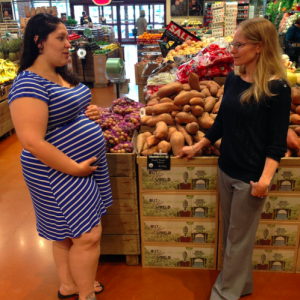
Since the publication of Rachel Carson’s 1962 seminal nonfiction book, “Silent Spring,” scientists have worked hard to understand the ramifications widespread pesticide use has on a host of organisms, including humans.
This fall, Cynthia Curl, an assistant professor in the Department of Community and Environmental Health, will take an important next step in this body of research. Curl has been awarded a three-year, $457,537 grant from the National Institutes of Health (NIH) to measure herbicide levels in pregnant women – specifically, glyphosate, an active ingredient found in many herbicides, including Roundup.
In 2016, glyphosate was controversially designated as a Probable Human Carcinogen by the International Agency for Research on Cancer (IARC); in August a jury awarded nearly $300 million to a school groundskeeper who said Roundup caused his cancer.
In addition, there also is emerging literature suggesting that in utero exposure to glyphosate and glyphosate-based herbicides may have reproductive effects and may adversely impact developing fetuses. Curl’s research will attempt to quantify how much glyphosate pregnant women are exposed to and how that exposure is occurring.
It’s important to note that “glyphosate is not a new chemical – it was developed by a chemist working for a pharmaceutical company in 1950, though its efficacy as an herbicide was not recognized until 1970. However, the way it’s now used is new,” Curl said.
Curl explained that the introduction of crops engineered to be “glyphosate-resistant” over the past two decades has entirely changed the agricultural landscape. Certain crops, including corn, soy, sugar beets, canola and cotton, are now genetically modified to be glyphosate resistant. This means that a farmer can spray an entire field of glyphosate-resistant crops with Roundup or other glyphosate-based herbicide and get rid of the weeds without harming the crop itself. Farmers also are now using glyphosate as a desiccant to dry certain crops before harvest.
“I do not think it is an exaggeration to say that these two expanded uses of glyphosate have caused its total application volume to skyrocket,” Curl said. “Glyphosate use has increased by more than 15-fold since the introduction of glyphosate-resistant technology in 1996.”
Curl’s three-year research project begins this fall with the development of an exposure assessment strategy, as existing studies of human exposure to glyphosate are limited and the chemical is metabolized fairly quickly.
“We don’t really have a good handle on how many individual urine samples we need to collect to do a reasonable job of estimating a person’s average glyphosate exposure,” she said. “A single urine sample only tells you about very recent exposure, so we will need to collect a series of samples over time to fully characterize longer-term levels.”
Curl will begin recruiting pregnant women in year two of the study. Half of the participants will be recruited from areas near agricultural fields treated with glyphosate, the other half from more urban areas.
“We’ll use the exposure assessment strategy developed during the first study year to figure out whether there is a difference in exposure between those two groups based on residential proximity to glyphosate-treated agricultural fields,” Curl explained. “Then we’ll provide all of the women in both groups with a fully organic diet for seven days to see how much glyphosate exposure comes from diet.”
Glyphosate, like other synthetic pesticides, is not allowed in organic food production. Organic food also prohibits use of GMO technology.
The body of data collected from these two groups of pregnant women will allow Curl and other researchers to better understand the important role of diet, as well as proximity to agriculture, with regards to total glyphosate exposure.